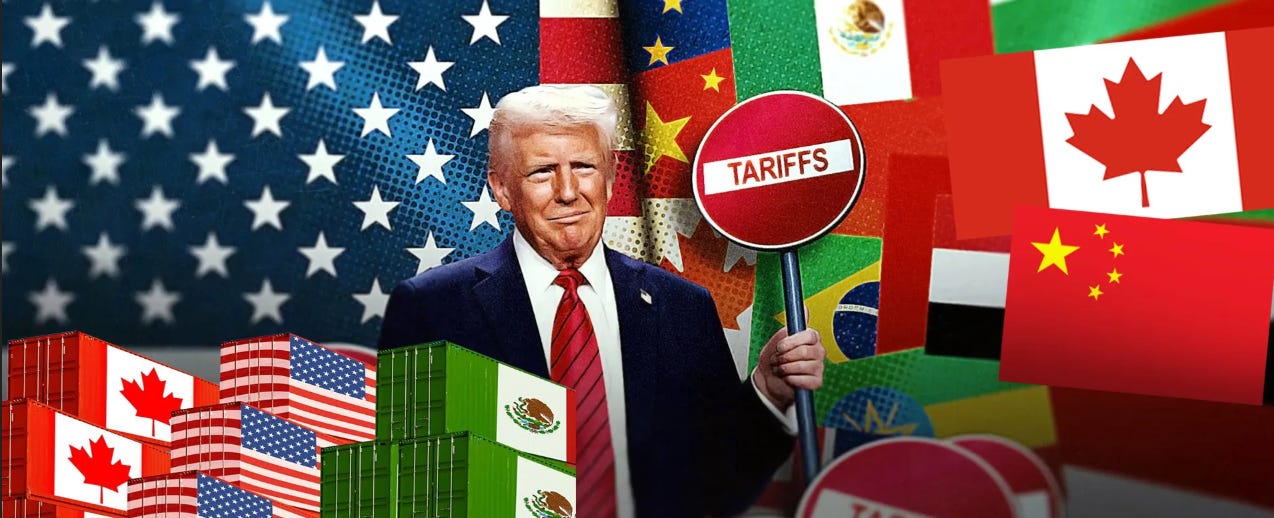Rhetorical question: If tariffs didn't work, why do so many other countries use them?
We already know why. They are effective at achieving the desired result.
This comes from a post I saw on Social-ist Media and while I don’t agree with all of the assumptions or conclusions, thought it worth sharing because I have some ideas regarding the outcomes that I think you’ll all find interesting.
PART 1: WHAT TO KNOW ABOUT TARIFFS (WITHOUT THE HYPE)
1. Tariffs are basically tolls. When products come into the U.S. from another country, a fee can be charged. Just like a toll on a highway. Simple as that.
2. Tariffs used to fund everything. Before the U.S. had income tax, tariffs helped pay for the government. It worked—and the country grew strong.
3. After WWII, we opened the door wide. To help other nations recover, America lowered its tariffs. That move sparked global trade. It was generous—and it changed the world.
4. But we never readjusted. Other countries kept their fees high. We didn’t. Over time, that made trade uneven. Companies use cheap labor to make cheap products and sell them back to America.
5. Now we’re making an adjustment. This isn’t about shutting the world out. It’s about rebuilding our own foundation—so we’re stronger for the future. For your kids!
6. Most countries charge way more. On average, India charges 50% on imports. The U.S.? Around 4%. The goal isn’t revenge—it’s balance.
7. Trade isn’t stopping. It’s shifting. Tariffs don’t end trade. They encourage local growth and true global partnership. It’s a way to protect jobs, rebuild supply chains, and strengthen independence.
8. Yes, some prices might go up. But not forever. We’re still importing—we’re just being more intentional. Think seasonal: mangoes in January. Still there… maybe just not as cheap.
9. Businesses are already adjusting. Companies are moving production back to the U.S. Others are investing in infrastructure. That means more jobs here, and more control over what we build. This takes some time but it’s already started!
10. It’s not selfish—it’s smart. We’ve helped the world rise from the ashes of WWII. Now we’re making sure we stay solid at home. So we can lead well into the future.
This isn’t about politics. It’s about understanding the moment we’re in.
PART 2: HOW TO STAY STEADY AND MOVE FORWARD
We don’t get to choose every challenge. But we do get to decide how we respond. There IS opportunity in everything!
1. Accept the moment. You don’t have to love tariffs—but they’re part of the landscape now. Instead of complaining, adjust. Learn. Adapt. Keep moving.
2. Pay attention to movement. Jobs are shifting. Manufacturing is shifting. Capital is flowing in new directions. If you follow the flow, you’ll find the opportunities.
3. Buy less. Create more. Inflation is real—but so is your ability to build, create, and invest. This is a great time to stop chasing trends and start building stability. - Love this one!!
4. America’s not breaking—it’s evolving. Every comeback starts with a shake-up. Things look messy because change is happening. That’s not a sign to give up—it’s a sign to get focused.
5. Your mindset matters most. If you focus on fear, you’ll get stuck. If you focus on opportunity, you’ll grow. What you look for is what you’ll find.
The world isn’t falling apart. It’s shifting. The real question is: What are you going to build with the new pieces?






Agreed!